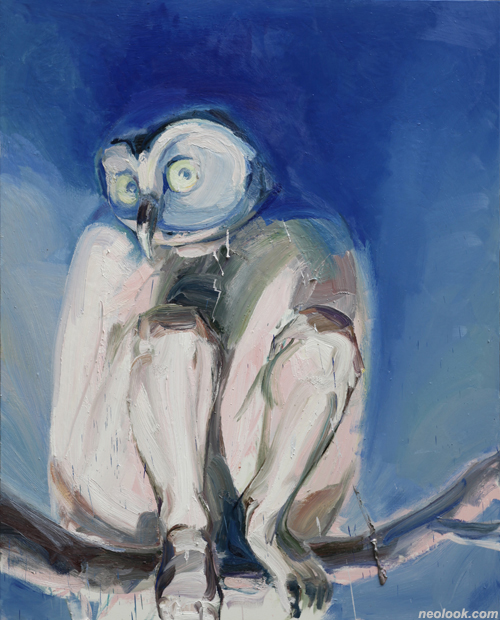- ● homepage
- ● archives
- ● restoration
- ● books
- ● big banners
- ● post board
- ■ neo's search
- ■ about us
- ■ 게재방법 안내
- 개인정보처리방침

- [email protected]
- Tel. 02_335_7922
- Fax. 02_335_7929
- 10:00am~04:30pm
- 월요일~금요일
- 3/3(월) 대체공휴일

미네르바의 올빼미는 황혼에 날개짓을 한다.
김진展 / KIMJIN / 金眞 / painting 2012_1013 ▶ 2012_1111 / 월요일,명절 휴관
● 위 이미지를 클릭하면 네오룩 아카이브 Vol.20110318f | 김진展으로 갑니다.
초대일시 / 2012_1013_토요일_05:00pm
The owl of Minerva spreads its wings only with the falling of the dusk.展
관람시간 / 11:00am~07:00pm / 주말,공휴일_11:00am~08:00pm / 월요일,명절 휴관
닥터박 갤러리 Dr.PARK GALLERY 경기도 양평군 강하면 강남로 469 Tel. +82.31.775.5602 www.drparkart.com
사물의 살(肉)과 빛 ● 김진은 자신을 둘러싼 사물들을 응시한다. 현실에서 벌어지는 온갖 사건들도 그 시선의 범주 안에 들어온다. 작업실 탁자 위의 사물들, 전단지에 실린 상품(채소와 과일, 고기)사진, 신문에 보도된 온갖 사건의 사진, 그리고 자신이 겪었던 상황 등 그 모든 것이 불현듯 다가와 가시처럼 박힌 것들이다. 순간 온갖 상념이 줄을 잇거나 이상한 낯설음이 엄습한다. 응시하던 눈들은 저마다 입을 달고 질문을 한다. 화가들은 사물이 갖고 있는 특성을 잡아채어 그것을 표현하는 이들이다. 사물을 바라보는 작가는 이미 지나간 후에 남겨진 잔해 같은 것을 끌어내어 미처 짐작하지 못한 사물의 특질을 길어 올리고자 한다. 그것은 사물의 형식 이면에 자리한 느낌, 질감, 빛과 연관되어 다가온다. 그러니까 그것은 '정념'을 불러일으키면서 맴돈다. 특정 대상은 어떻게 나에게 다가오는가? 그것이 자아내는 정념은 어떻게 표현될 수 있는가? 김진은 그런 질문에 회화로서 응답한다.
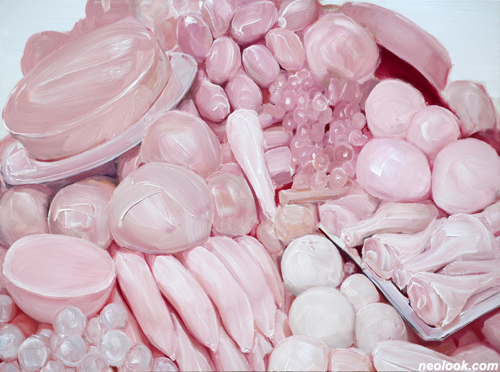
- 김진_정물화nature morte#1_캔버스에 유채_97×130cm_2011
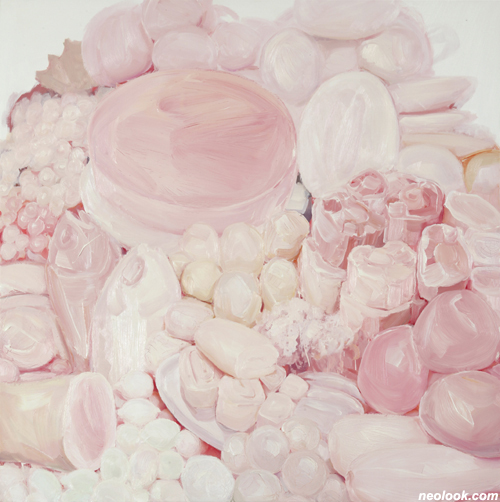
- 김진_정물화nature morte#2_캔버스에 유채_150×150cm_2012
헤겔의 '미네르바의 부엉이'에 대한 단상, 데모 진압용 조명등의 발광하는 빛들(공권력의 폭력성을 암시), 작업실 탁자 위에 놓인 잡다한 사물(일상) 등을 감각적인 붓질로 그려내는 김진의 회화는 사물의 형태를 규정하는 윤곽선 없이 그대로 색채와 질감과 선이 동시에 공존하면서 지나간다. 작가는 오래 전에 접한 문징명(1470-1539)의 서예를 보고 매혹되었던 경험을 말했다. 그 붓질, 한 획이 지닌 무시무시한 힘, 필력과 한정된 공간에 자리한 절묘한 포치에 마냥 매료되었던 것이다. 문징명의 작업은 평면회화의 가능성을 다시 돌이켜보는 계기로 작동했고 다시금 왜 회화여야 하는지에 대한 당위성을 부여해 준 계기였던 것 같다. 그래서인지 김진의 회화는 붓질의 대담함과 분절된 터치들이 자아내는 민첩함, 속도감이 느껴진다. 붓질이 지나간 궤적과 순서를 고스란히 노출하는 물질성 또한 두드러진다. 그것은 특정 대상인 동시에 오로지 붓질이고 그 붓질은 또한 단순한 선이 아니라 색채이자 질료 모두를 함축하고 있다. 그것은 이성적인 판단과 구성에 의해 조율되는 것이 아니라 색채를 지닌 질료들의 감각적 배치와도 같다. ● 모든 대상은 결국 그것을 보는 이의 정신 속에 자리한다. 영국의 경험론자들은 감각이야말로 모든 인식의 근원이라고 보았다. 감각적인 성질이 인간 의식에 있는 것이 아니라 의식을 벗어난 저 쪽 세계의 진짜로 존재한다고 여긴 대표적 존재가 메를로퐁티이다. 그는 사물을 '감각덩어리'라고 했다. 사물을 하나의 색 덩어리로 본 것이다. 사실 주변의 모든 사물은 결국 색을 통해 주어진다. 사물은 색 덩어리, 즉 속속들이 색으로 된 덩어리인 것이다. 들뢰즈는 이를 신경체계적 감각이라고도 말했는데 그것은 신경이라는 물질이 감각과 구분 없다는 뜻이다. 미술은 무엇보다도 감각을 가장 중요시 한다. 회화란 여러 감각적인 내용을 배치하는 것이다. 사물의 풍부하고 깊이 있는 감각적인 얼굴을 표현하는 것, 그것이 결국 회화란 얘기다. 김진이 추구하는 회화가 혹 그런 것은 아닐까?
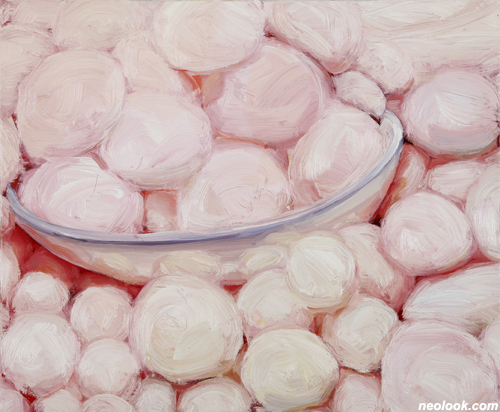
- 김진_정물화nature morte#4_캔버스에 유채_50×60.6cm_2012
김진은 또한 사물을 통해 연상되는 것을 그리고자 한다. 연상은 관념들이 체계를 이루는데 있어 기본 바탕이 되는 것을 일컫는다. 연상이란 관념들이 정신 속에서 작동하는 것을 말한다. 관념은 희미한 인상과도 같은 것이다. 어떤 사물을 보았을 때 어떤 생각이 떠오르거나 감정이 느껴지는 것은 무엇 때문일까? 그 모든 감정이나 생각을 관념으로 보고 그 관념들이 갑자기 힘을 발휘하는 것은 연상에 의해서라고 주장하는 철학자들이 있었다. 대표적으로 후설은 대상이 드러나 자아를 촉발함으로써 인식이 시작된다고 본다. 그 연상은 근본적으로 주체의 의지하고는 무관하게 일어나는 것이다. 그것은 주체도 어찌 할 수 없는 정신의 근본적인 힘이 작동하는 것이다. 따라서 사물을 통해 일어나는 상상은 의도를 넘어서는 것이다. 그러니 화가란 존재는 그 연상의 힘이 얼마나 넓고 깊게 발휘되는 가에 의해 가늠된다. 그리고 그것이 상상력의 위력 또한 결정한다. 김진이 그리는 사물은 자신이 지각한 내용 자체이다. 사물은 관념들의 다발이다. 메를로퐁티는 "몸은 항상 자기가 아니다" 라는 말을 했다. 그것은 순수 자아가 아니라 분열된 자아를 칭한다. 자아는 인식하기 쉽지 않은 대단히 불투명한 존재다. 그 자아는 무수한 사물, 대상을 만나면서, 접속되면서 수시로 새롭게 형성된다. 김진의 그림은 자신의 자아와 접촉한 사물, 대상과의 관계에서 파생된 느낌, 정념을 온전히 포착하고자 한다. 재현하고자 한다. 무엇인가가 의식에 떠올랐을 때 의식에 떠오른 내용을 표상(재현)이라고 한다. 그리고 그렇게 무엇인가를 의식에 떠올리는 것을 표상한다(재현하다)라고 말한다. 작가는 문득 일상 속에 자리한 비근한 사물들을 통해서, 여러 이미지를 통해서 그리고 자신이 경험한 사건들 안에서 포착한 정념을 재현한다. 표상한다.
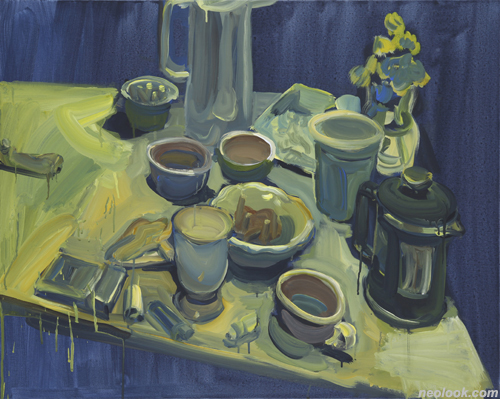
- 김진_내부의 외부자#1_캔버스에 아크릴채색_72.7×91cm_2011
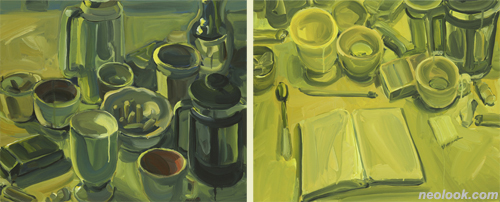
- 김진_내부의 외부자#2_캔버스에 아크릴채색_50×60.6cm_2011 김진_내부의 외부자#3_캔버스에 아크릴채색_50×60.6cm_2011
김진의 그림은 정물화에 유사하다. 화병과 꽃이 아니라 일상의 사물들을 그렸다. 삶의 지평에 널러 있는 것의 하나가 사물이다. 사물은 늘 발가벗은 존재이다. 사물은 우리 인간의 욕구와 욕망을 넘어서 자리한다. 특정 상황을 넘어서 있는 것이다. 상황을 넘어서 있다는 것은 "하나의 독특한 상황일 수밖에 없는 주체로서는 감당할 수 없다는 뜻"이다. 주체가 사물 자체의 영역으로 다가가고자 한다면 그것은 주체가 자신의 본령을 버리고 자신의 죽음을 각오한 것이다. 사물 자체의 영역은 욕구 또는 욕망과 도구의 연관 즉 인간됨의 구도를 벗어난 영역이라 보아야 한다는 것이다. 따라서 사물 자체의 영역으로 접근해 간다는 것은 들뢰즈가 말하는 것처럼 인간됨을 버리고 그 바탕인 동물의 차원으로 내려가는 것일 수도 있고 샤르트르나 메를로퐁티가 말하는 순전한 감각인 살의 차원으로 내려가는 것일 수도 있다는 것이다. 이때 사물은 감각과 구별되지 않는다. 사물은 감각덩어리 자체가 된다. 만약 우리가 사물 자체의 영역으로 하강하게 되면 사물과 인간 둘 다 감각덩어리인 사물로서 서로 완전히 뒤엉켜버린다. 그래서 사르트르는 존재론적으로 가장 강렬한 성질로서 끈적끈적한 질감을 얘기한다. 끈적끈적함은 사물이 감각덩어리로서 질겅질겅 녹아 내리는 것을 의미한다. 김진 역시 사물 자체가 뿜어내는 관능적인 질감덩어리, 발산하는 빛에 매료되었다. 일체의 도구 및 상황의 연관을 벗어나 버린 사물 자체의 세계에 주목한다. 그런 맥락에서 나는 김진의 작업실에서 본 어떤 그림보다도 탁자 위에 놓여진 사물들을 무심한 붓질로 쓱쓱 쓸어 담듯이 그린 그림과 환한 분홍빛 하나만으로 모든 사물들의 지시색, 고유색의 체계를 망실시키고, 눈을 멀게 하고, 무화시키고 오로지 하나의 빛으로, 덩어리로 꿈틀거리는 정물그림이 좋았다. 그것은 눈이 부신 빛이자 폭력적인 빛이기도 하고 욕망하게 하는, 눈 멀게 하는 소비자본주의 시대의 무서운 빛이자 죽은 사물에 존재감을 부여하여 환생시키는 빛이기도 하다. 그러니 김진이 그려내는 정물화의 사물들은 결코 죽은 사물(불어로 정물을 뜻하는 'nature morte'는 '죽은 자연'이라는 의미다)이 아니다. 과잉의 붓질과 용량을 초과한 빛의 투사, 원근이 파기된 공간에 사물의 피부에 집중된 시선, 사물 자체가 지닌 살의 전면화가 김진 회화의 특징이다. 존재의 저 끈적거리는 살의 향연을 회화의 살, 붓질로 가 닿고자 한다. 자신이 그 사물에서 느낀 정념을 표현하고자 하는 것이다. 그것은 오로지 감각적인 붓질과 물감의 질료성, 빛으로 이루어진 회화의 가능성 안에서 자리한다. ■ 박영택
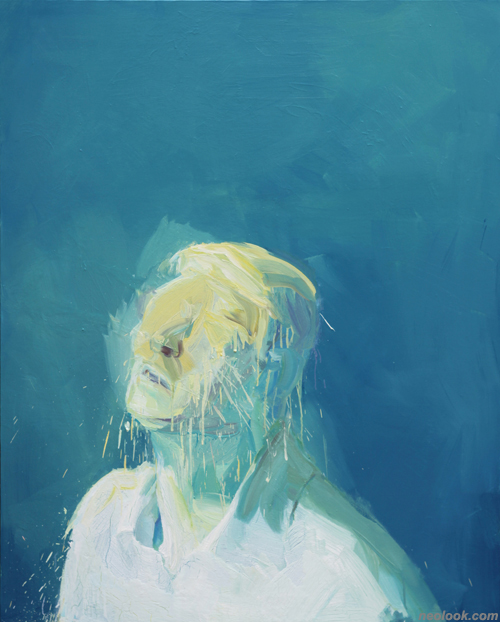
- 김진_무제_캔버스에 유채_162×130.5cm_2012
The Flesh of Things Represented by Light ● Kim Jin gazes at things about her. All events taking place in reality stay in the category of her gaze. All things, on the table of her studio, photographs of commodities like vegetables, fruit, and meat on advertisement flyers, photographs of various events reported in newspapers, and situations she underwent come close and are embedded in her paintings, when the painter is seized by a chain of thoughts and strange unfamiliarity. Gazing eyes have mouths asking a question. Painters capture and depict object features. Looking at things Kim takes debris from things, drawing out their distinctive characteristics. The debris is related to a feeling behind things, texture, and light, creating pathos. How does a specific object come close to me? How can pathos from debris be expressed? Kim replies to such questions in painting. ● Kim sensuously represents fragmentary thoughts about Hegel's 'owl of Minerva,' lighting for riot-suppression (suggestive of public power and violence), miscellaneous things on his studio table. In her paintings colors, texture, and lines coexist without outline defining the form of objects. The artist said she was captivated by calligraphy by the Chinese artist Wen Zhengming (1470-1539). She was attracted by the brushwork, tremendous power of Wen's brush strokes, and exquisiteness in a finite space. It seems Wen's work served as momentum for Kim to reconsider the possibility of painting. Audacious brushwork, agility and speed from segmented brush strokes are sensed in Kim's painting. Physical property revealing the trajectory and order of brushwork also stand out. Her brush strokes are not simple lines but connote color and material. Her brushwork is free of rational judgment and composition: it is sensuous arrangements of material bearing color. ● All objects place in the spirit of one who sees them. British empiricists saw sense as the source of all cognition. Maurice Merleau-Ponty believed sensuous characters are not in human consciousness but exist in the world beyond consciousness. He regarded objects as a mass of the senses. He saw a thing as a mass of color. All things around us are given to us through color. Art above all emphasizes sense. Painting is arranging sensuous content; that is, presenting or representing an object's abundant, profound sensuality. Isn't Kim's painting thing like this? Kim also depicts what an object associates with. ● An association can be the basis of ideas to form a system. Association here refers to working of ideas in the spirit. An idea is like an impression. Why does some idea come to mind when seeing a thing? Some philosophers asserted all emotions and thoughts are ideas, and such ideas exert their power by association. Edmund Husserl considers recognition begins when the self is stimulated by objects. An association occurs, irrelevant to a subject's will, by the fundamental force of the spirit the subject cannot address. Any imagination derived from objects is thus beyond intention. A painter's ability can be determined by how such association is broad and profound, which also determines the power of his imagination. Things Kim portrays are what she perceived. An object is a bundle of ideas. Merleau-Ponty stated that "The body is not always one's own." With this she refers to a divided self, not a pure self. The self is very vague and uneasy to recognize. The self is newly formed, meeting and contacting numerous things and objects. Kim's painting tries to capture and represent things in contact with her self, feeling and emotion derived from her connection with objects. What comes across to one's consciousness is 'manifestation' (representation). The artist manifests and represents her pathos captured in events she experienced through things and images about her daily life. ● Kim's painting is akin to still-life painting featuring daily things, pervasive in our lives. In a naked state things are beyond our want and desire, transcending any specific situation. Transcending a specific situation means a situation is too much for the subject. If the subject intends to access the arena of objects, the subject should be ready for death, giving up its true nature. The domain of things is a sphere distant from the domain of humanity or arena of want and desire. To approach the sphere of things means descending to the level of animal, discarding humanity, as Gilles Deleuze stated, or coming the level of the sense or flesh as Jean Paul Sartre and Maurice Merleau-Ponty cited. The object is not distinguished from sense. The object becomes a mass of senses. If we come to the domain of objects, things and humans tangle as a mass of senses. Sartre thus regards sticky texture as ontologically the most intense trait. Stickiness means a melting of objects as a mass of senses. Kim Jin is also lured by masses of sensual texture of a thing, and the light the thing emits. She pays attention to the world of things departing from connections with devices and situations. In this sense her paintings depict things on the table in unintentional brushwork and still-lifes erasing or destroying the system of the referent, with the inherent colors of things wriggling like a mass or light. This is dazzling light, violent light, scaring light of desire making us lose our sight of capitalism; the light of bringing life to dead things. The things of her still life paintings are not dead: the French 'nature morte' referring to still-life, means 'dead nature'. Kim's painting is characterized by a plethora of brush stokes, projection of excessive light, space with a destroyed perspective, gaze concentrating on a thing's skin, and emphasis on the flesh of a thing. She contacts the flesh of being through the flesh of painting. Kim represents pathos she feels in things through sensuous brush strokes, paint's materiality, the possibility of painting by light. ■ PARK YOUNG-TAEK
Vol.20121013c | 김진展 / KIMJIN / 金眞 / painting

